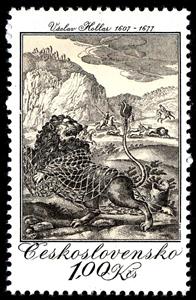Stamp: The Lion and the Mouse, by Vaclav Hollar (1665) (Czechoslovakia 1975)
The Lion and the Mouse, by Vaclav Hollar (1665) (Czechoslovakia 1975)
26 February (Czechoslovakia ) within release Hunting themes of old engravings goes into circulation Stamp The Lion and the Mouse, by Vaclav Hollar (1665) face value 1 Czechoslovakian koruna
| Stamp The Lion and the Mouse, by Vaclav Hollar (1665) in catalogues | |
|---|---|
| Michel: | Mi:CS 2241 |
| Yvert et Tellier: | Yt:CS 2084 |
| POFIS: | POF:CS 2123 |
Stamp is square format.
Also in the issue Hunting themes of old engravings:
- Stamp - The Lion and the Mouse, by Vaclav Hollar (1665) face value 1;
- Stamp - Deer Hunt, by Philip Galle (1578) face value 1.60;
- Stamp - Grand Hunt, by Jacques Callot, detail (1619) face value 1.80;
Stamp The Lion and the Mouse, by Vaclav Hollar (1665) it reflects the thematic directions:
Painting is the practice of applying paint, pigment, color or other medium to a solid surface (support base). The medium is commonly applied to the base with a brush, but other implements, such as knives, sponges, and airbrushes, can be used. Painting is a mode of creative expression, and the forms are numerous. Drawing, gesture (as in gestural painting), composition, narration (as in narrative art), or abstraction (as in abstract art), among other aesthetic modes, may serve to manifest the expressive and conceptual intention of the practitioner. Paintings can be naturalistic and representational (as in a still life or landscape painting), photographic, abstract, narrative, symbolistic (as in Symbolist art), emotive (as in Expressionism), or political in nature (as in Artivism). A portion of the history of painting in both Eastern and Western art is dominated by spiritual motifs and ideas. Examples of this kind of painting range from artwork depicting mythological figures on pottery, to Biblical scenes rendered on the interior walls and ceiling of the Sistine Chapel, to scenes from the life of Buddha or other images of Eastern religious origin. In art, the term painting describes both the act and the result of the action. The support for paintings includes such surfaces as walls, paper, canvas, wood, glass, lacquer, clay, leaf, copper and concrete, and the painting may incorporate multiple other materials including sand, clay, paper, plaster, gold leaf, as well as objects. The term painting is also used outside of art as a common trade among craftsmen and builders.
Hunting is the human practice of seeking, pursuing, capturing, or killing wildlife or feral animals. The most common reasons for humans to hunt are to exploit the animal's body for meat and useful animal products (fur/hide, bone/tusks, horn/antler, etc.), for recreation/taxidermy (see trophy hunting), although it may also be done for non-exploitative reasons such as removing predators dangerous to humans or domestic animals (e.g. wolf hunting), to eliminate pests and nuisance animals that damage crops/livestock/poultry or spread diseases (see varminting), for trade/tourism (see safari), or for ecological conservation against overpopulation and invasive species.


